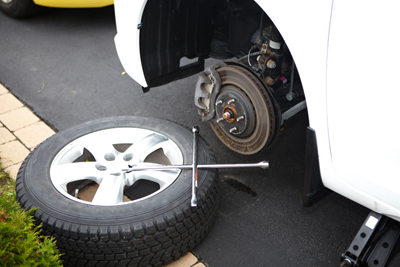 So you have “mushy brakes”. Maybe you have an intermittent problem where the brake petal goes too far down. So you checked the brake pads and brake drums and they are OK. What does that leave? The most likely problem is the master cylinder and power booster. Replacing those parts will cost over a thousand dollars for parts alone. Maybe you should take a long look at the calipers first. Repairing the calipers is much less expensive and may solve the problem.
So you have “mushy brakes”. Maybe you have an intermittent problem where the brake petal goes too far down. So you checked the brake pads and brake drums and they are OK. What does that leave? The most likely problem is the master cylinder and power booster. Replacing those parts will cost over a thousand dollars for parts alone. Maybe you should take a long look at the calipers first. Repairing the calipers is much less expensive and may solve the problem.
What causes the brake caliper to stick?
Caliper Slides
The brake caliper has grooves that hold the brake pads. The brake pads slide in when the driver pushes down on the brake pedal, and they slide out when the driver lets off the brake. If the brake pads stick in the grooves, drivers may experience difficulty stopping. The brake pads can get stuck due to debris, but if cleaning out the grooves doesn’t solve the problem, it’s possible that the grooves themselves will wear down. If this is the case, the calipers may need a complete replacement.
Caliper Bolts
The brake caliper bolts also have slides. The slides have rubber boots on them to keep them well lubricated. However, sometimes the rubber boots tear, which causes the bolts to dry out. If this happens, the brakes may stick. Have a licensed technician take a look at the brake assembly to determine whether the bolts need reconditioning or replacement.
Caliper Piston
The caliper piston may be the culprit. Like the bolts, the caliper piston has a rubber boot around it meant to protect and lubricate it. If the rubber boot tears, then rust and other debris slowly build up inside of the piston. In this case, the brake caliper may stick. If this is the problem, it’s likely that the whole brake caliper assembly needs replacement.
Brake Hose
Sometimes a vehicle’s brake hose wears out. If this happens, it’s possible that brake fluid will only flow one way, causing the brake pads to slow the vehicle. However, when the driver doesn’t apply the brakes, the fluid cannot flow the opposite way, resulting in a stuck caliper. This problem is difficult to diagnose, but an experienced professional should be able to isolate the problem with the brake caliper.
How To Avoid a Stuck Brake Caliper
Take care of the vehicle’s brakes. Make sure to replace the brake pads and top up the brake fluid when needed. Make sure to bring the vehicle into an auto repair shop if problems with the brake caliper come up.
Lim’s Auto Body is a full service auto body and mechanical repair shop locally owned and operated in Largo, Florida. For more information, go to our web site www.limsautobody.com or call (727) 422-3232.

